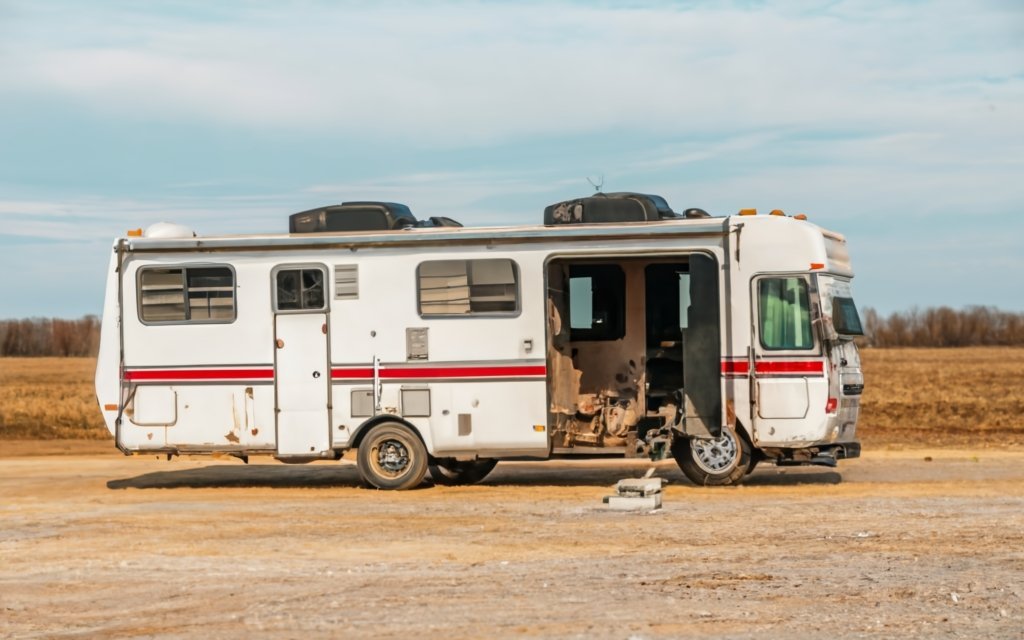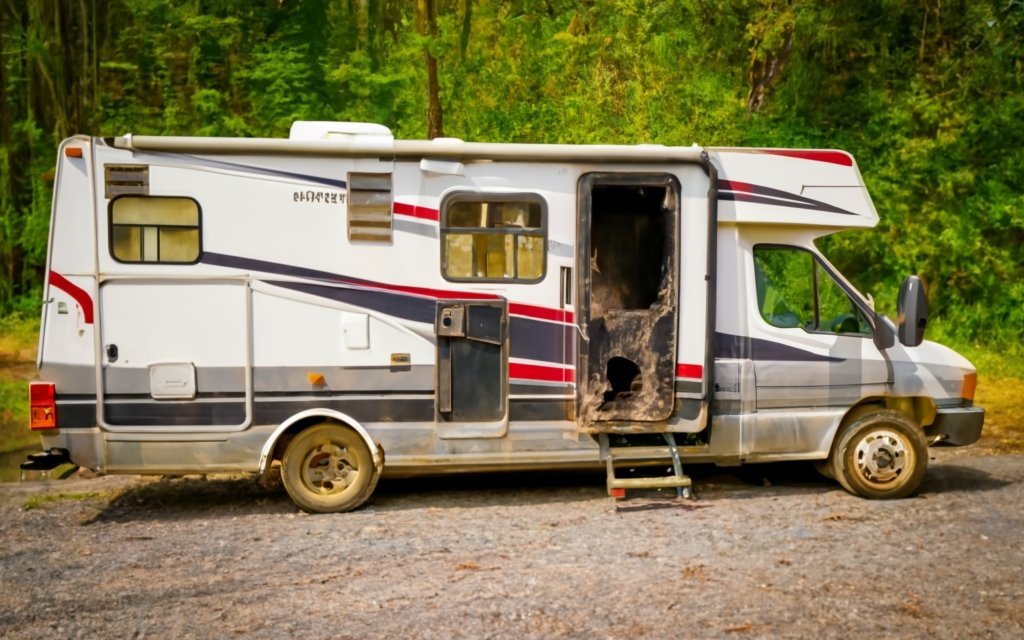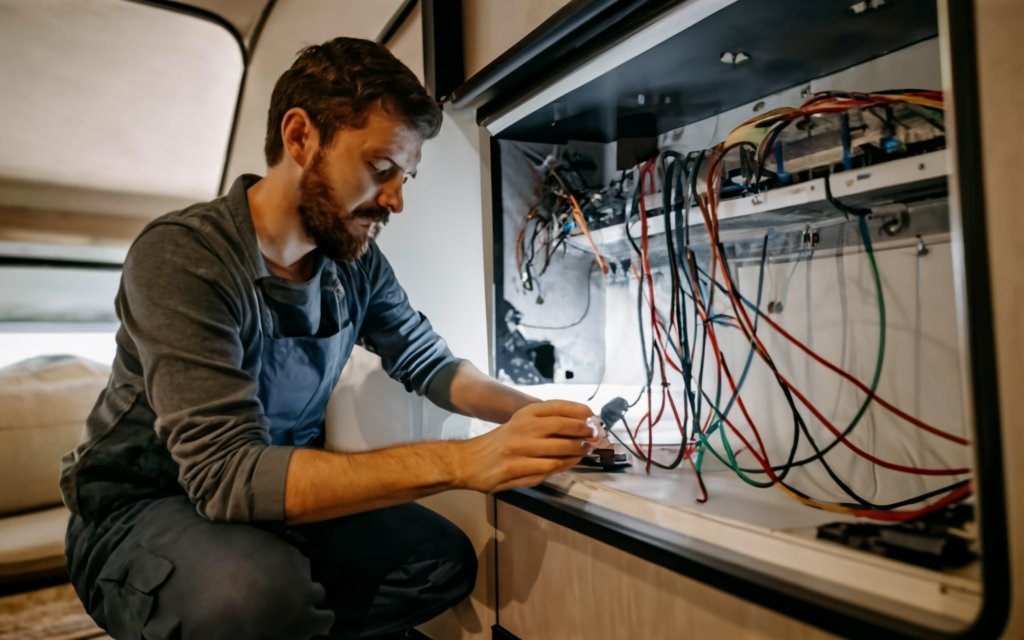Here’s what happens when the RV converter goes bad:
1. Power Supply Issues:
- Battery Charging Problems: The primary function of the converter is to charge the RV’s 12-volt batteries when connected to shore power. If the converter fails, the batteries won’t charge properly, leading to:
- Reduced battery life
- Difficulty starting the RV’s engine
- Dimming or flickering lights
- Reduced functionality of 12-volt appliances
- Inconsistent 12-Volt Power: The converter also supplies 12-volt power to run various RV systems. A faulty converter can cause:
- Erratic operation of lights, fans, water pumps, and other 12-volt appliances
- Inconsistent refrigerator temperature
2. Signs of a Failing Converter:
- Dimming or Flickering Lights: This is a common indicator of a converter issue.
- Slow-Spinning Vent Fans: The converter powers vent fans, and slow-spinning fans can signal a problem.
- Non-Functional Cooling Fan: The converter itself has a cooling fan, and if it’s not operating, it’s a sign of trouble.
- Overheating or Swollen Batteries: These can be caused by a malfunctioning converter.
- Strange Smells: Sulfur or burning odors from the electrical system may indicate a failing converter.
3. Potential Consequences of a Bad Converter:
- Damaged Batteries: A faulty converter can overcharge or undercharge batteries, shortening their lifespan.
- Inoperable RV Systems: Without a working converter, many RV systems that rely on 12-volt power will not function properly.
- Safety Hazards: Electrical issues can create fire risks or cause damage to appliances and electronics. Another article you need to read to learn more about RVs is >>>> Why Does My RV Water Pump Pulsate? to learn more about RVs.
The RV Converter: Your Tiny Titan of 12-Volt Glory (and When It Throws a Tantrum).
Picture this: You’re nestled deep in the Yosemite wilderness, campfire crackling, stars shimmering. Suddenly, the lights dim, the fan sputters, and the fridge… well, let’s just say it starts humming a chilling dirge about spoiled milk. That, my friends, is the chilling whisper of a dying RV converter.
Don’t panic! While a bad converter can dampen the adventure vibes, it’s not a death sentence. But before we crack open the toolbox, let’s demystify this little electrical hero and its potential meltdowns.
Part 1: Your 12-Volt Powerhouse – Meet the RV Converter
Imagine this: You plug your RV into shore power – that magical 120-volt AC juice from the campground. But hey, your fridge runs on 12-volt DC, and your lights crave a lower-voltage diet. Enter the converter, the silent transformer lurking behind your breaker panel. It’s like a culinary translator, whipping up that 12-volt feast your appliances crave.
Here’s the nitty-gritty:
- Transformer: Drops the high voltage down to manageable levels.
- Rectifier: Turns the AC into DC pulsations.
- Voltage Regulator: Smoothes those pulsations into steady 12V DC.
- Battery Charger: Keeps your RV’s batteries plump and happy with a controlled charging current.
Think of it as the Gordon Ramsay of your electrical system, meticulously crafting the perfect voltage for every appliance. But even Ramsay can have an off night, and that’s when things get… interesting.
Part 2: When the Lights Dim and the Fridge Weeps – Signs of a Converter Gone South.
It’s not always a dramatic bang. Sometimes, the signs of a failing converter are as subtle as a dimming campfire ember. But don’t underestimate their power to ruin your RV bliss.
Dimming Lights and Erratic Appliances: This is the classic canary in the coal mine. Fluctuating voltage makes your lights flicker like a disco ball on low battery, and appliances become moody teenagers, throwing tantrums (slow-spinning fans, flickering LEDs) instead of working seamlessly.
Battery Blues: Think of your batteries as hungry puppies. A healthy converter keeps them fed with a steady charge. But a malfunctioning one? It might leave them malnourished (unable to hold a charge) or overstuffed (overheated and swollen). Both scenarios are bad news, trust me.
Beyond the Obvious: Sometimes, the clues are less direct. Unexplained tripped breakers? That could be the converter overloading the system. Strange noises or vibrations? Internal components crying out for help. And that sulfur smell? Yeah, that’s a red flag the size of Texas.

Remember: It’s not just about inconvenience. A neglected converter can wreak havoc on your batteries, and appliances, and even start electrical fires. So, when you see the first flicker of electrical weirdness, listen up!
Stay tuned for Part 3, where we’ll dive into diagnosing and repairing the electrical gremlins, and Part 4, where we’ll share tips to keep your converter humming happily ever after.
In the meantime, keep an eye out for those warning signs, and remember: Even the mighty Gordon Ramsay burns toast sometimes. But knowing what to look for can keep your RV adventure on track, even when the electrical gremlins try to steal the show.
Bonus Tip: Check out our “RV Converter Troubleshooting Table” for a quick reference guide to common symptoms and their potential causes. And don’t forget to share your own converter horror stories (and triumphs!) in the comments below!
The RV Converter Autopsy: Diagnosing and Repairing the Electrical Gremlins.
Okay, folks, the lights are flickering, the fridge is wailing an operatic lament of spoiled milk, and you suspect the converter. Time to don your Sherlock Holmes hat and crack open the electrical case!
DIY Detective or Pro Help?
Before grabbing the screwdriver, assess the situation. Are you a handy DIY enthusiast with a multimeter and basic electrical knowledge? Great! Grab our helpful “RV Converter Troubleshooting Table” below for clues. But if smoke, sizzling sounds, or electrical buzzing are on the guest list, call the pros immediately. Remember, your safety and your RV’s health are top priorities.
Table 1: RV Converter Troubleshooting Table
| Symptom | Possible Cause | DIY Fix or Pro Help? |
|---|---|---|
| Dimming/flickering lights | Unstable voltage | Emergency! Disconnect all power sources, evacuate RV, and call emergency services. |
| Erratic appliances | Voltage fluctuations | Same as above. Check for overloaded circuits. |
| Dead interior lights | Complete 12V power outage | Check batteries, fuses, and main breakers. If no luck, call a pro. |
| Batteries won’t hold a charge | Faulty charging circuit | Reduce appliance usage, and check for faulty wiring. If persistent, call a pro. |
| Overheated/swollen batteries | Overcharging | Disconnect shore power immediately! Call a pro for diagnosis and repair. |
| Unexplained tripped breakers | Converter overload | Stop using the converter! Disconnect shore power and seek professional help. |
| Strange noises/vibrations | Internal component failure | Emergency! Disconnect all power sources, evacuate the RV, and call emergency services. |
| Burning smell/smoke | Electrical malfunction | Emergency! Disconnect all power sources, evacuate the RV, and call emergency services. |
Remember: This table is a starting point, not a definitive guide. When in doubt, err on the side of caution and seek professional help.
The Repair Toolbox:
If you’re DIY-inclined, here’s your basic toolkit:
- Multimeter: Your electrical stethoscope, measuring voltage, current, and resistance.
- Screwdrivers: For accessing terminals and connections.
- Electrical tape: For safe insulation after repairs.
- Replacement fuses: Just in case (consult your RV manual for the correct type).
Pro Tip: Always disconnect shore power and turn off all appliances before tinkering with the converter. Safety first!
Part 4: Converter CPR: Keeping Your Powerhouse Pumping.
Prevention is always better than cure, so let’s give your converter some TLC:
- Regular Inspections: Visually check the converter for signs of overheating, burning, or loose connections.
- Proper Usage: Avoid overloading the system (don’t run the hairdryer and microwave simultaneously!). Use surge protectors for sensitive electronics.
- Seasonal Storage: Disconnect batteries and properly store the RV to prevent converter drain.
Bonus Tip: Invest in a quality converter with features like surge protection and pure sine wave output for a longer lifespan and less electrical drama.
By following these tips and paying attention to those warning signs, you can keep your RV’s 12-volt heart humming happily for years to come. Remember, a healthy converter means happy lights, happy appliances, and happy adventures. So go forth, explore, and let the electrical gremlins be a distant memory!

And don’t forget: We’re always here to help! Share your RV converter experiences, questions, and tips in the comments below. Let’s keep the electrical campfire crackling on!
Part 5: Beyond the Converter Blues: Related Topics to Electrify Your Knowledge.
So, we’ve dissected the converter, diagnosed its ailments, and even given it a good old electrical CPR. But let’s not stop there! Here are some electrifying bonus topics to expand your RV electrical IQ:
1. Battery Bonanza: Your 12-Volt Sidekicks.
Batteries are the unsung heroes of RV life, silently storing 12-volt power for your off-grid adventures. But choosing the right type, maintaining their health, and understanding proper charging techniques are crucial for a trouble-free journey. Dive into:
- Deep-cycle vs. starting batteries: Which ones are best for your power needs?
- Maintaining proper water levels and preventing sulfation for longer battery life.
- Understanding charging profiles and choosing the right charger for your battery type.
- Harnessing the power of the sun with solar panels and portable generators.
2. The Inverter Enigma: From DC to AC and Back Again.
Sometimes, you need that 120-volt AC hum for certain appliances like hair dryers or laptops. That’s where the inverter steps in, magically transforming your 12-volt DC into usable AC. Explore:
- Different inverter types (modified sine wave, pure sine wave) and their impact on appliance performance.
- Sizing your inverter to match your power needs (avoid using a hairdryer with a puny inverter!).
- Understanding inverter efficiency and minimizing energy drain on your batteries.
- Exploring alternative AC power sources like shore power adapters and propane generators.
3. The Wiring Web: Your RV’s Electrical Nervous System.
Just like our bodies with their intricate network of nerves, RVs rely on a complex web of wires to carry the electrical current. Knowing the basics of this system can help you troubleshoot minor issues and avoid electrical mayhem:
- Recognizing different wire types and their voltage capacities.
- Understanding grounding and its importance for electrical safety.
- Locating your RV’s fuse panel and identifying fuses for specific appliances.
- Learning basic wire splicing and repair techniques (for the truly adventurous!).

4. The Tech Tsunami: Embracing Gadgets and Gizmos.
Technology is constantly evolving, and the RV world is no exception. From smart generators and solar controllers to lithium batteries and app-controlled appliances, there’s a whole world of electrical advancements waiting to be explored. Research:
- The latest tech trends in RV power management and energy efficiency.
- Smart gadgets and apps that can simplify your electrical system and optimize your power usage.
- Innovative solutions for off-grid adventures, like fuel cell generators and water-powered turbines.
- The future of RV electrical systems and its impact on sustainability and adventure.
Remember: Knowledge is power, especially when it comes to your RV’s electrical system. By delving into these related topics, you’ll be better equipped to handle any electrical hiccups, maximize your power resources, and truly own your RV adventure. So, don’t just conquer the mountains, conquer the electrons too!
Conclusion: Powering Your Adventures – One Converter at a Time.
So, there you have it, folks! The RV converter: your tiny titan of 12-volt glory, the silent magician behind every flickering light and humming fridge. Remember, it’s not just about keeping the lights on. A healthy converter is the backbone of your off-grid independence, the silent guardian of your RV’s electrical health.
But like any mighty hero, it can stumble. The key? Listen to its whispers. Dimming lights, finicky appliances, that sulfur whiff – they’re not annoyances, they’re battle cries for help. Heed them, diagnose them with care, and treat them with either DIY magic or professional prowess.
Above all, remember this: knowledge is power, especially when it comes to electrons. Embrace the related topics, explore the battery bonanza, understand the inverter enigma, navigate the wiring web, and ride the tech tsunami.
With every ounce of electrical knowledge you gain, you empower your adventures. You conquer not just mountains and oceans, but the whispers of the unseen wires and circuits. So, go forth, adventurers! Let your electrical IQ shine, and may your converters hum happily ever after, powering your journeys far and wide.
Remember, the wilderness awaits, not with flickering lights and dead fridges, but with starry skies, crackling campfires, and memories that shine brighter than any 12-volt bulb. Your RV, with its silent titan at its core, is your key to unlocking those adventures. Now go, explore, and power your dreams!
Bonus Tip: Share your electrical tales, wisdom, and converter woes in the comments below! Let’s keep the electrical campfire crackling in a community of informed adventurers.
This conclusion wraps up the article with a sense of empowerment and encourages readers to embrace their RV adventures with newfound electrical knowledge. It also includes a call to action for engaging with the community and sharing experiences.

Welcome to the enchanting world of Genah Reney, the esteemed Author-in-Residence at BAF TOURS International. Genah is not only a master storyteller but also a guiding force in weaving narratives that elevate the travel experience. Her literary prowess mirrors the essence of BAF TOURS, creating a seamless blend of captivating stories and the allure of global exploration.






